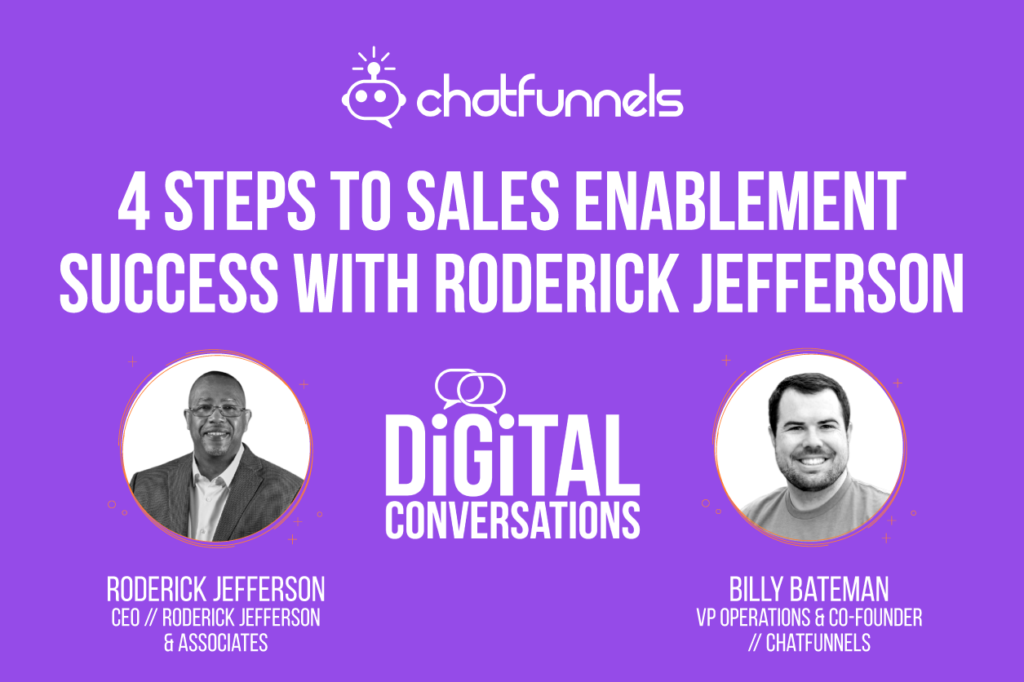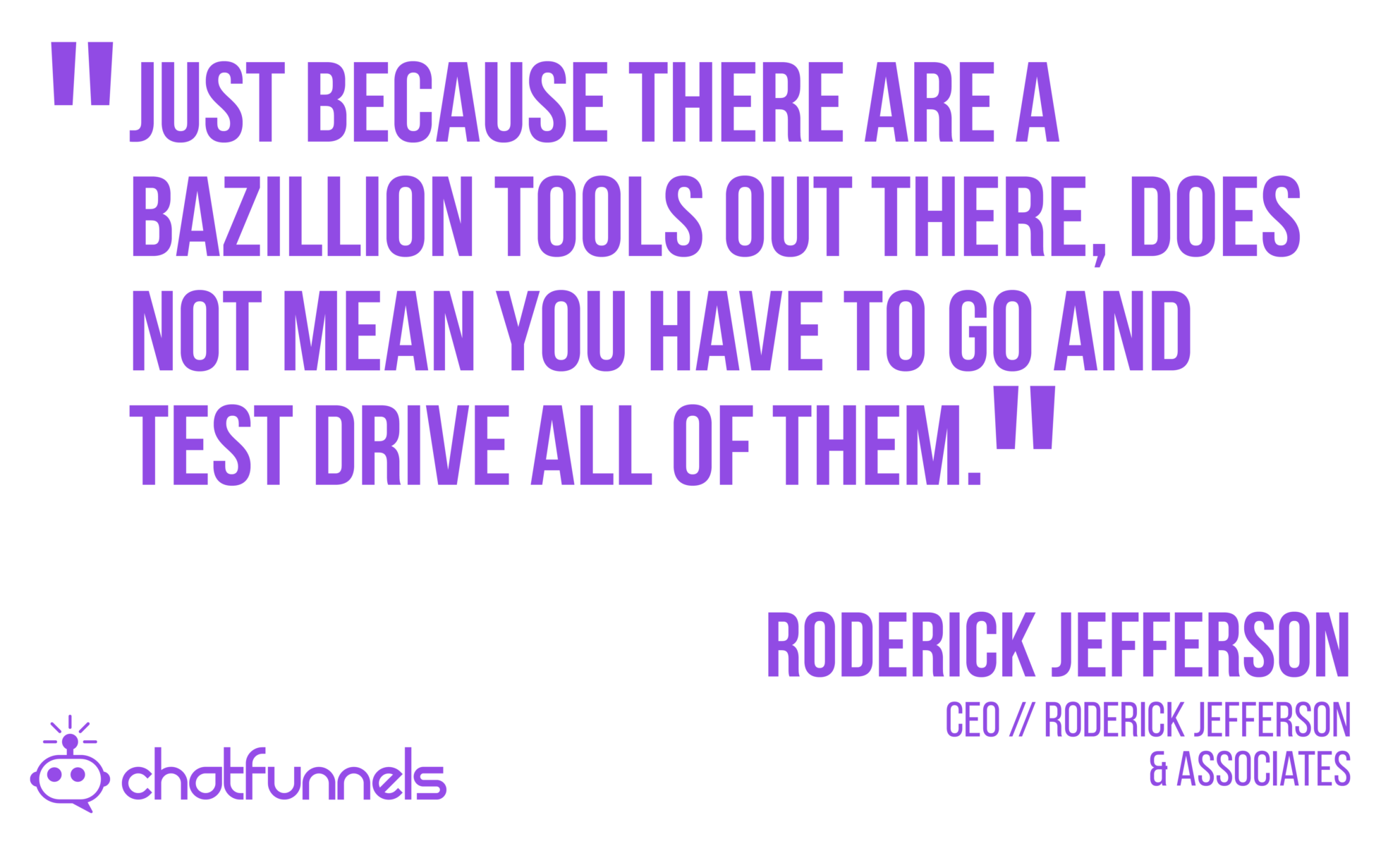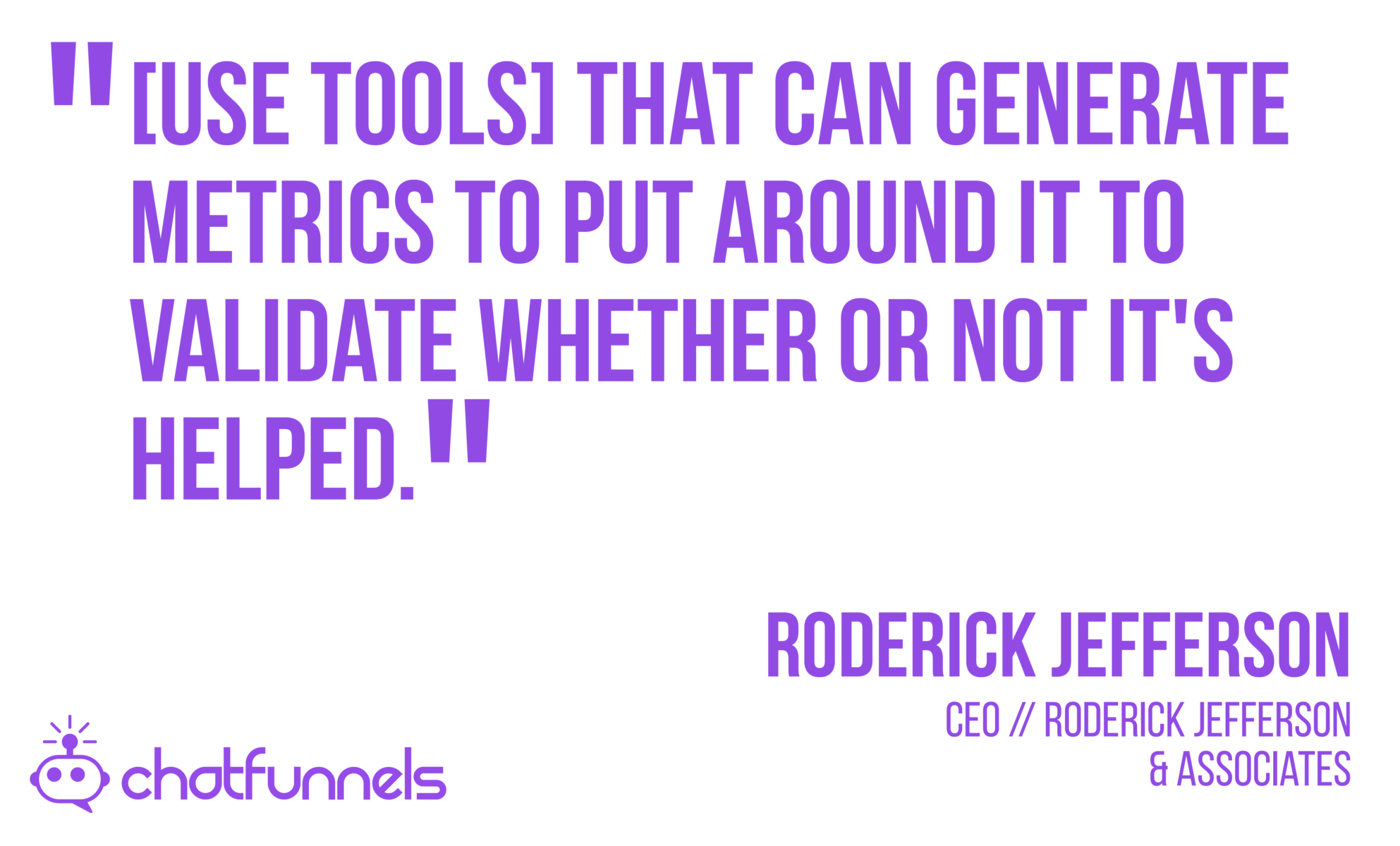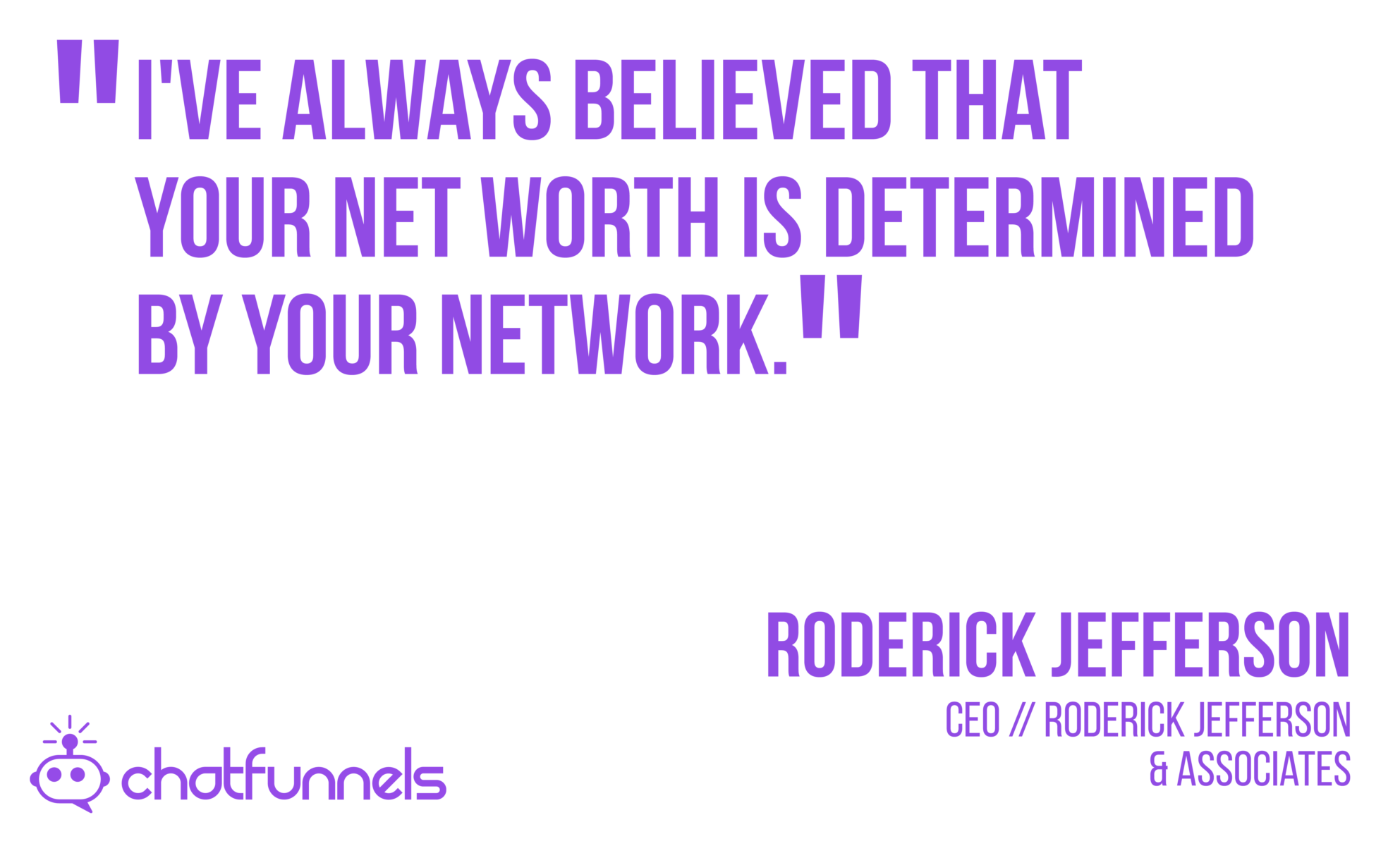4 Steps To Sales Enablement Success with Roderick Jefferson

On this week’s episode of Digital Conversations, Billy is joined by Roderick Jefferson, CEO of Roderick Jefferson and Associates. Roderick outlines how to improve your sales enablement, and suggests tools and tech that can assist you in your efforts.
Listening Platforms:
Transcript
Billy: Alright everyone, welcome to the show today. I am your host, Billy Bateman. And today, my guest is Roderick Jefferson. RJ How you doing, man?
Roderick: Fantastic, man. How are you?
Billy: I’m doing good. I’m doing good. I’m excited to talk about our topic today, tools for sales teams. But before we hop into that, could you just tell everybody a little bit about yourself?

Roderick: Sure. I’m Roderick Jefferson. I’m the CEO of Roderick Jefferson and Associates. We’re actually a sales enablement and sales coaching firm, focused primarily in the SMB space. So, it’s where I grew up and where my heart is, and where I think we can make the most impact.
Billy: Awesome, awesome. And then before we hop into this, I’m going to ask you, I ask everybody this. So if we’re going to look you up on social RJ and try to figure out who you are, what’s something that there’s zero chance we’re gonna figure out about you.
Roderick: Oh, great question. Um, let’s see. Here’s one for you. I actually have a full size bocce ball court built in my backyard.
Billy: That is awesome. I bet not many people have that. The first one I know. So okay, well, let’s hop into it then. So tools for sales teams, particularly focusing in on that SMB space. At a base level, what tools do you recommend for your SMB sales team?
Roderick: I think there’s a number of categories. And I’ll start with learning management and content management systems, right? Make sure that you’re utilizing those and that you’re giving feedback on those. That’s the important part right? Then you’ve got your prospecting and your sales reporting tools and things like LinkedIn Navigator Salesforce, ZoomInfo, smaller companies like autobalance.ai. You got your sales readiness platforms, the Lessonly, ShowPads, MindTickle and those types. Another category is communication tools, everything from our online zoom meetings to reference guides, playbooks, etc. Now, here’s the one that I use a lot. And most folks think of it as a simple calendaring tool. And that’s alendly. Now, the way I look at Calendly differently, I look at it as a productivity tool. It stops having to go back and forth with prospects or customers.
Hey, are you available today at 1? Nope, I can do Wednesday at 9. I can’t do that. Can you do Thursday. Instead, you say, here’s the link to my calendar. With the available slots. Let’s find something that works for both of us. And that works out to be an enormous time saver, plus the productivity tool. Another is training and coaching tools. And then finally, you’ve got your, your podcast libraries and your playlist things like Gong and Chorus and such.
Billy: So let me ask you this. There are a ton of different tools as you just went through in different categories. And within each category, you’ve got a couple of competitors for each one, and they’ve all got their pros and cons. But, let’s say you’re a startup, you’re kind of running lean on getting that sales team going. If you’re just like bare bones, here’s my stack I would recommend for you. What would that be?
Roderick: Well, it starts with prospecting. Right? Because in order to keep the doors open, you got to find that new sales. And the one that I love is autobound.ai. They’re a small startup themselves, right? And they’re fighting in the same category as the Salesforce, but I think they do something different. They allow you to build profiles for, I think it’s three different ideal customer profiles. And then it ties into HubSpot. And I think they’re now tied into Salesforce as well. But what it does is it pulls in your contacts and allows you to literally, on the fly, you can adjust your outbound messaging, you can send it as is as a template. Or if you got some specific, it’s literally so easy to use. It’s not even funny, and so easy to navigate.
And the UI on it is actually pretty slick. So that’s one, right. Another is LinkedIn, and LinkedIn Navigator. Got to have those pieces so you can get to the right folks. ZoomInfo is another so you can get direct contact info. I say LinkedIn from a different perspective, because I’ve always believed that your net worth is determined by your network. That to me is the biggest tool you have above any of the automation platforms that are in place. Nothing will ever replace a handshake and a relationship. Because those can open doors for you that you don’t even realize there’s a house there.
Right? And then I’ll round it out with got to have the distance learning tools got to have Zoom, that’s a given right, because we’re all remote right now and it’s about building relationships. And let me put in a caveat. Don’t talk about something you see on the wall behind someone. Oh, I see you went to University of Texas. Oh, I see your you like to fish. Respect this individual because they have invited you into their home or into their office. Right? Build a rapport, person to person, eyeball to eyeball.

None of that the extemporaneous what’s going on around you kind of stuff, that’s just background. Unless it’s like, Hey, we both went there at the same time I saw Do you remember so and so that we used to do or what happened at the games? That’s different, right, as opposed to trying to build rapport. And the last is distance tools like you know, webinars and podcasts. You gotta have something for podcast because we’re, we’re a mobile society. No one’s going to be strapped to a desk anymore. So since you’re moving around, we’re not going to the gym, but some are still working out.
We’re going on walks, we’re moving around, right? I will not sit and watch an hour long episode of something. But I will listen to six five minute podcast. Why? Because it gives me knowledge bytes. Then there’s the Gong and the Chorus, the coaching tools. And no, it sounds like a lot. All of this doesn’t happen at once. Right? This is kind of the buildup of things. Because if you can’t coach, you can’t give immediate feedback right now on the spot in that moment in time.
Billy: So let me ask you this. This is something that that I’ve had a conversation with a few people on, you can use the Gong and the Chorus.ai to automate a lot of giving that feedback and that coaching, but is it really that much better besides time saving than having your sales manager watch a demo or to just record it and send it over to them and have them go through it or, or sit there in the background.
Roderick: Yes, it is. And the reason is, when I’m having a conversation right now, I’m distracted by what’s going on around me in that particular moment. If I’m going back to watch a replay, I’ve made a concerted effort to go give you my undivided attention. That’s one. Second, is it’s not just as a coaching tool, think about how you can utilize those tools for onboarding, right. For continuous education, for product releases for a competitive landscape update. And here’s a great thing that you don’t get with just a sales manager. We know that people move around, and when COVID slows down, they’re going to be people changing jobs, there are people changing jobs today.
You don’t want to have your rockstar salesperson or dev person, whatever it may be, walk out the door and the legacy information and tenure leave with you. What you want to be able to do is harness that. And that’s what Gong course does, is allows you to harness all of that tribal knowledge, and all those best practices. So when they go out of the door, guess what stays; all the best practices and the knowledge bytes.
Billy: That’s a great point. I like that. I like that. So we’ve gone through like this base level stack, what tools do you think truly provide the most value in terms of one productivity, and then two, just like helping you get deals across the finish line?

Roderick: I’m gonna give you an answer that may sound inverse, and it’s not. That’s kind of like saying, don’t take this the wrong way. Yeah, but what I’m going to say is, it depends upon the maturation point of your company. Yeah, whether you’re a brand new startup, or whether you’re further along down the line, and it also depends on what your ideal employee profile looks like, as well as your ideal customer profile. So it comes down to any tool that’s going to do one of two things, help your prospects and customers accelerate speed to revenue, and increase productivity and efficiency, or to decrease pain.
Billy: That makes sense. That makes sense. Okay. So the example then so let’s, maybe you could, I’m sure you’ve got to have a story or two, and you have to name names, but a story of like, hey, we put in a tool or two here, and it made all the world of difference once they learned to use it.
Roderick: They had no lack of content. What they had was no structure. And they also had no strategy for it. So what they did was they put in a tool, and it allowed them to segment the content, get it to the right individual, and level at the right time, that fit across not the selling stages or the selling motions of the selling methodology, but that align to their buyers journey and where the buyer was, and then tied all their selling motion back upward to the buyers journey. That was a game changer.
Because now I’m getting information to my BDR, SDR on the top of funnel, I’m getting the right information to be shared. If a buyer says this, here’s some content and assets to share with them. As you close and you’re going towards that transitional meeting over to your customer success manager, here’s some best practices and here’s things you can share with them so that they know we have a roadmap and we’re not hoping it works on their dime, but we actually have a strategy.
And what happens is you start building cohesion from the front of the house, SDR, BDR, sales, SE’s to the back of the house customer success and customer support. Now you built a big beautiful house with no short hallway where folks are tuning out of the back door, because their touch points along the way. And you’re also giving them for lack of a better word, a guided tour. And a warm fuzzy along the way, too.
Billy: Yeah. No, that makes sense. I like it. I like it. What tool was that they put in place to help manage the content?
Roderick: ShowPad.
Billy: Cool. Awesome. Okay, so what mistakes have you seen with people trying to implement tools for their sales team?
Roderick: How much time do we have?
Here’s the thing. Common mistakes I see are waiting too long to go get to it. And that’s because they’re not listening, that leadership generally is not listening to sellers. Another common problem I have is getting enamored with shiny objects. And what I mean is, just because there are a bazillion tools out there, does not mean you have to go and test drive all of them. And the third and most important is getting a tool without having a true outcome and metrics to put around that tool to validate whether or not it’s helped me to increase productivity and efficiency or decrease pain.

Billy: Yeah, the last one, I agree with all of them. But really the last one was that you buy any piece of software, or any tool, it’s like, Okay, how are we going to measure the real outcome from this? And did we get a payoff from it? You got to pick whatever that one or two metrics are. Much faster to give a fair evaluation of anything.
Roderick: And before we move on to the next, I want to say this, the biggest above all of those is this. If your first and second line managers or leaders don’t own the adoption, the execution, and the modeling of using those tools, I don’t care what you buy, they’re going to become shelf ware.
Hundred percent, or the manager above them is gonna spend six months fighting them to use the tool. And yeah, at that point, maybe they do it.
We’re all sales folks. If I know that, let’s say we use Salesforce, and my manager is still using spreadsheets for forecast meetings, I know that I can put junk in Salesforce because he’s never gonna see it or she’s never gonna see it, it won’t matter. But if everything is done in a given tool, and I know they’re proficient in it, and I know when we have our one on ones, we’re talking out of that tool. Guess what happened? The whole adage, what’s important to your manager or leader, is imperative to you.
Billy: Absolutely. For sure. Okay, so let’s, let’s shift a little bit and let’s just talk about the future of sales enablement. Where do you see that headed? There’s a lot of changes. I mean, even like, we work with a lot of marketing and sales teams. And usually whenever marketing buys like a chatbot, puts it on the site and tells the sales team, hey, this is gonna make your life easier. They’re like, No, no, no, this is to take away my job is initially their first reaction. So you know, and sometimes that’s what marketing thinks they want to do. Honestly, they’re like, Oh, we can save some money by have the bot do these. Not always the best way to do it honestly. And I love the bot you know that’s our business.
Roderick: It serves a purpose, right? But it is not the answer to every question.
Billy: No it’s not, it’s not. Having an SDR team that works with a bot is what I think is often the best solution.
Roderick: You can’t you lose the human touch? Right? We have to, even with the deeper integration of AI and ML, is figure out a way how to humanize these tools and platforms and not lose that touch. So to answer your question, where’s enablement going? Yeah, well, I’m actually writing a book on that. I called Designing, Building, and Deploying Sales Enablement 3.0. Because I 1.0 was you know, traveling salesman and such. 2.0 was all the way up through, you know, scientific buying and platforms like CRM and all the ones that we’ve talked about where we’re going now is really a fundamental shift. Because like everyone else, we’ve never experienced such a significant shift in the buyer and the sales landscape like we’re dealing with right now.
Right? Not only was it not expected, but it seemed to happen overnight. And let’s be honest, selling and as a sales leader, and sales enablement, can be challenging, even the best of times. But the challenge in navigating sales leadership, sales enablement for the last six months has been, I think, nothing short of overwhelming. So we’ve got to change how we are enabling folks and I think there are kind of four steps in which to do this. And the first is around focus.

And that means focusing your energy, your goals and your deliverables on the things that you can touch an impact and also that directly aligned with your company’s goals. There’s a lot of noise out there, right? And so everything beyond that, has to be just noise. Because there’s a lot of do more with less right now. There’s a lot of cutbacks. So you’ve got to really put your stake in the ground. The next is connect. And that means making connecting relationships, not just connecting connections on social media. Look, I love social media, and you know, I’m all over it. I’m about it. Yep. I think social media, in one sense, has given us access to people and buyers, we have never had a chance to touch. And then in another sense, it’s made us less social.
Billy: Oh, I couldn’t agree more.
Roderick: Realistically, relationships are, they’re the backbone of success. Man, there has never been a time like right now. Where leading with humanity, empathy, and EQ has meant more than it does right now. I think we’re still defining EQ in most companies, but it has to be in place today. The next is pivoting and adapting. Yep, I know, pivoting is the cool buzzword right now, that’s not what I’m talking about.
I’m talking about pivoting to deliver deeper value around things like improving discovery and qualification skills, mapping back to, as I said earlier, the buyers landscape and helping companies to increase profit, reduce costs and risk mitigation. Before we could talk about, oh, we’re going to help you accelerate speed to revenue, we’re going to help you maintain customers for life. Right now, it’s literally about how do we help our customers hold on to the customers they have right now. And the way we do it is focusing on the things I was just talking about. Reducing costs, mitigating risks, and stop talking about selling products and not even solutions.
It has to shift now to the experience of working with my company that you can only get here. Because we understand you. We work with people that look like you And we have a roadmap and we are here for the long term. We made it through COVID. That says something right there. So we’re here with you. And the final piece is commitment. And I mean, committing to incorporating a different and an innovative strategy, this 3.0 that I’m talking about now, yeah, post pandemic into your go to market strategy as a key differentiator. Right, internally and externally. Because I think if we do it right, we can really be a component of the go to market strategy that can accelerate our companies as the cleared thought leaders in our space.
Billy: I love it, man. I love it. So when’s the book coming out, RJ?
Roderick: End of year, it goes to the editor on the 15th, and I am feverishly trying to figure out what I need to pull out versus putting in. I’ve given literally my heart and soul of 25 years to it and I actually just released a course on Udemy called the art and science of sales enablement that is a precursor and kind of an excerpt from the book.
Billy: Awesome. Awesome. Okay, man, we will probably have to have you back on when the book comes out so we can talk about that. I’ll have to read out there. So, okay, dude, thanks so much. It’s been a great conversation. And if people want to get ahold of you, where do they, where can they get ahold of you?
Roderick: Look, I’m gonna say this up front. If you really want to connect with me, and you can’t find me, you’re not trying. We are all over social media. You can find my company on LinkedIn, under Robert Jefferson and Associates, on Twitter, you can email me info@roderickjefferson.com, you can go to roderickjefferson.com on the web. Or you can find us on Instagram at Roderick_J _associates. We’re out there, wherever where we are where you are.
Billy: Okay, man. Appreciate it and we’ll chat later.
Roderick: Thanks for the opportunity man, really appreciated.
